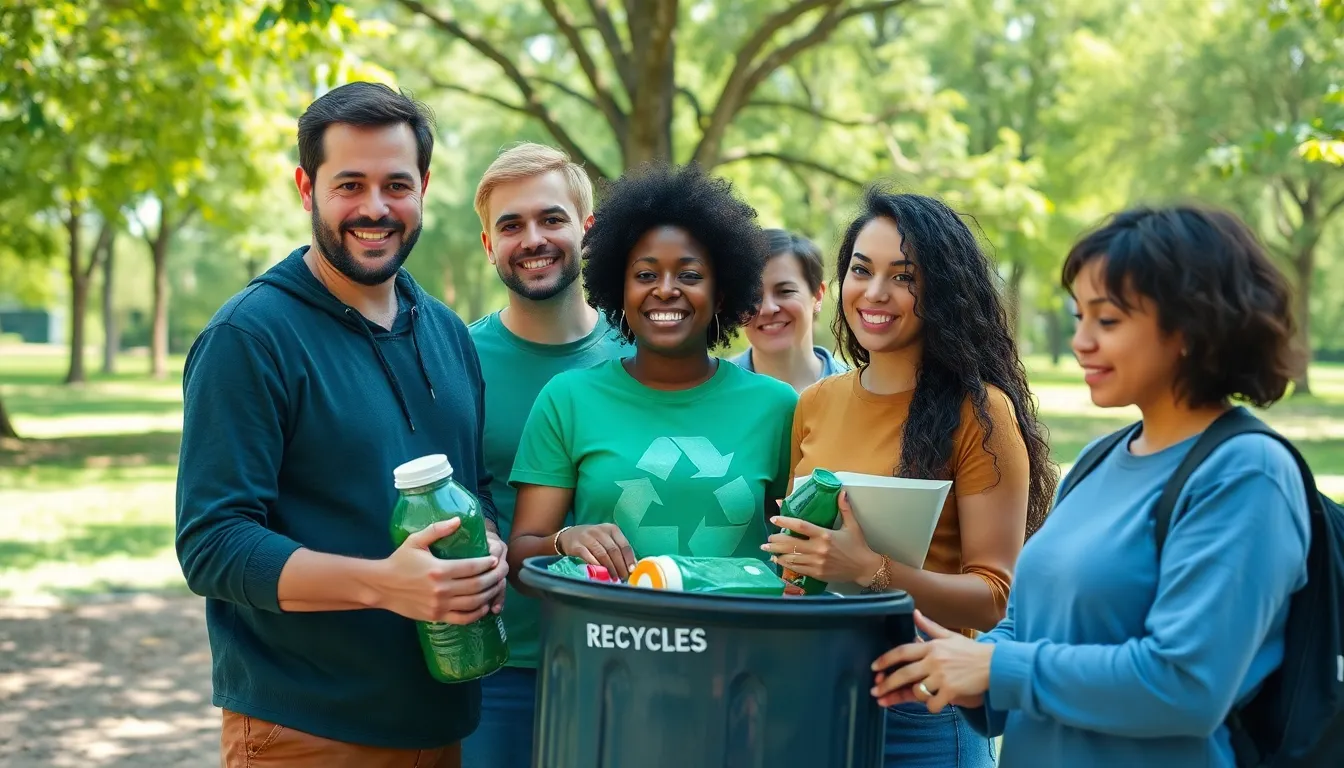Imagine a world where waste is just a myth, and everything gets a second, third, or even fourth chance at life. Welcome to the circular economy, where recycling isn’t just a buzzword but a way of life. This innovative approach flips the traditional linear model on its head, transforming how we think about resources and waste.
In a circular economy, products are designed to last, materials are reused, and nothing goes to waste—kind of like your favorite pair of jeans that you just can’t let go of. By embracing these principles, businesses and individuals can not only save money but also contribute to a healthier planet. So buckle up as we dive into the principles of the circular economy and discover how they can revolutionize our everyday lives while keeping the planet spinning in the right direction.
Table of Contents
ToggleUnderstanding Circular Economy Principles
Circular economy principles focus on creating a more sustainable approach to resource management. These principles guide industries and individuals toward minimizing waste and maximizing resource efficiency.
Definition of Circular Economy
A circular economy refers to an economic system that aims to eliminate waste through continual use of resources. Instead of the traditional linear model, which promotes a ‘take, make, dispose’ approach, circular economy fosters a closed-loop system. It emphasizes restoring and enhancing the natural environment. Products are designed for durability, repairability, and recyclability. Technologies and innovations play a vital role in this transition, enabling materials to return to the production cycle.
Key Components of Circular Economy Principles
Key components of circular economy principles encompass several fundamental practices. Resource conservation promotes efficient usage to extend the lifespan of materials. Product design includes features that facilitate recycling and reuse. Consumer engagement encourages individuals to make sustainable choices. Collaboration among businesses and stakeholders fosters a shared responsibility for sustainability. Lastly, innovation drives the development of new materials and processes, ensuring a continuous cycle of resource use without harm to the environment.
Benefits of Circular Economy Principles

Circular economy principles present numerous advantages across various sectors. These benefits extend to the environment, economy, and society, promoting a more sustainable way of life.
Environmental Benefits
Environmental improvements rank high among the advantages of circular economy principles. They lead to reduced waste generation, promoting recycling and composting instead of landfilling. Increased resource efficiency minimizes the extraction of raw materials, lowering greenhouse gas emissions associated with production. Implementing sustainable practices also enhances biodiversity, fostering healthier ecosystems. Durable product design supports longer use, decreasing the frequency of disposal. Overall, these measures significantly decrease environmental impact, aligning with global sustainability goals.
Economic Benefits
Economic gains arise from adopting circular economy principles. Cost savings emerge through reduced material expenses and efficient resource management. Businesses can lower operational costs by utilizing recycled materials instead of virgin resources. Job creation occurs through new industries that focus on repair, recycling, and reuse. Revenue generation increases as companies tap into innovative business models built on sustainability. Increasing consumer demand for sustainable products also drives growth, reflecting a shift toward environmentally-conscious purchasing behaviors.
Social Benefits
Social improvements accompany the shift to circular economy principles. Healthier communities result from reduced pollution, enhancing overall quality of life. Engaging the public in sustainability initiatives fosters a sense of responsibility and collective action. Educational opportunities grow through awareness programs about resource conservation and sustainable practices. Inclusivity enhances as circular economy strategies promote fair job practices and support local economies. This holistic approach contributes to thriving societies, where individuals are empowered to make a difference.
Implementing Circular Economy Principles
Implementing circular economy principles involves several strategies and collaborative efforts. Businesses play a crucial role in this transition, as their decisions directly impact resource management and sustainability.
Strategies for Businesses
Adopting sustainable practices forms the backbone of business strategies. Companies can focus on designing products for longevity to encourage reuse and reduce waste. Implementing take-back schemes enables firms to recover products at end-of-life stages. Investing in recycling technologies enhances materials recovery rates. Partnering with others in the supply chain fosters innovative solutions that prioritize sustainability. Training employees on circular practices promotes an organizational culture aligned with eco-friendly goals.
Role of Policy and Regulation
Government policies and regulations significantly influence circular economy implementation. Establishing frameworks encourages businesses to adopt sustainable practices. Policies that incentivize recycling and waste reduction can drive commitment to circular principles. Regulations mandating eco-design promote product longevity and recyclability. Funding for green innovation supports research and development of sustainable materials. Collaborations between public and private sectors can enhance resource management efficiency.
Challenges in Adopting Circular Economy Principles
Adopting circular economy principles faces significant barriers that hinder progress toward sustainable practices.
Economic Barriers
Economic constraints often impede the transition to a circular economy. Initial investments in sustainable technologies or materials may deter businesses since they require substantial capital outlay. Moreover, the lack of financial incentives for recycling and reusing materials can limit motivation for companies to shift away from traditional linear models. Market demand for cheaper products frequently prioritizes convenience over sustainability, creating further challenges. Compounding these issues, the absence of established supply chains for recycled materials can lead to higher costs and reduced competitiveness, making it difficult for new circular initiatives to gain traction.
Cultural and Behavioral Challenges
Cultural norms and consumer behaviors present another layer of complexity in adopting circular economy principles. Many individuals still adhere to the traditional ‘take, make, dispose’ mindset, exhibiting reluctance to engage in sustainable practices. Education plays a crucial role in fostering awareness about the benefits of recycling and reusing products, yet many communities lack effective programs. Consumers often prioritize price and convenience, with limited motivation to change their purchasing habits. Additionally, resistance from industries accustomed to linear production processes can hinder collaborative efforts, further complicating the shift toward a circular economy.
Case Studies of Circular Economy Principles in Action
Circular economy principles are being successfully integrated in various sectors, showcasing innovative approaches to sustainability.
Successful Examples
The fashion industry highlights the impact of circular economy principles through brands like Patagonia. This company prioritizes repair and recycling, offering customers the option to return worn items for refurbishment. Interface, a flooring manufacturer, embraces a closed-loop system where old carpets are recycles into new products, significantly reducing landfill waste. In electronics, Dell’s initiatives demonstrate commitment to technology sustainability by using recycled materials in device production and providing take-back options for end-of-life products. These examples illustrate the potential for businesses to not only minimize waste but also create new economic opportunities.
Lessons Learned
These case studies reveal several important lessons for implementing circular economy principles. First, collaboration among stakeholders is vital; businesses, consumers, and policymakers all play a role in promoting sustainable practices. Second, consumer education enhances engagement; when customers understand the benefits of circular products, they make more sustainable choices. Third, innovation drives success; companies that invest in new materials and processes benefit from creating unique value propositions while reducing their environmental impact. Lastly, measuring progress is essential; utilizing metrics helps businesses assess the effectiveness of their circular initiatives and make informed decisions for improvement.
Embracing circular economy principles is essential for fostering a sustainable future. By prioritizing resource efficiency and waste reduction, individuals and businesses can significantly impact environmental health. The shift towards a circular model not only conserves resources but also stimulates economic growth and social well-being.
As more organizations adopt these practices, the potential for innovation and collaboration increases. Overcoming challenges requires commitment and education, ensuring that sustainability becomes a priority in everyday decisions.
Ultimately, the circular economy offers a pathway to a more resilient and equitable society, where everyone plays a role in creating a cleaner, greener world.





